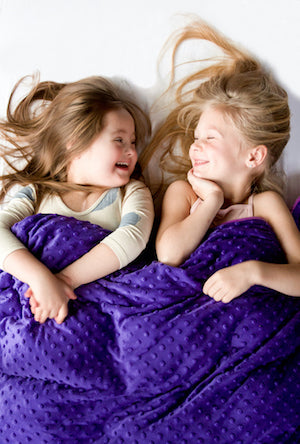
WHAT IS A WEIGHTED BLANKET AND WHAT ARE THE BENEFITS?
by Casey Ames
HARKLA
Weighted blankets have skyrocketed in popularity over the last two years thanks to their benefits becoming more mainstream, with many people finding that they are the best gift for people with anxiety since they help to promote sleep and better health.
If you are just hearing about weighted blankets now, don’t worry, we’ll cover everything you need to know about what weighted blankets are, as well as why they are helping tons of people improve their sleep.
The interesting thing about weighted blankets is that they have been around and in use for years with the special needs community. This is a typical pattern for therapeutic products. They are used first for those who need them most, then they slowly become mainstream as people realize that they can benefit almost anyone, becoming buyable from vendors online such as weighted blanket amazon, on both general and more specialized sites.
The reason they have become mainstream is that people have started to realize that weighted blankets work for anxiety and typical sleep issues, and aren’t just for children, but work great for adults.
Most adults, as well as children, could use a little extra help relaxing and improving sleep.
This article will cover the general overview and benefits of a weighted blanket. However, we love to really cover topics in-depth here at Harkla in order to give you the information you need.
If you want to dive deeper into weighted blankets for specific topics, check out these other articles on our blog:
- Weighted Blankets for Autism
- Weighted Blankets for Anxiety
- Weighted Blankets for Sleep and Insomnia
- Weighted Blankets for ADHD
Before we look at if weighted blankets work or not, let’s go over what a weighted blanket is, in case you are new to them.
WHAT IS A WEIGHTED BLANKET?
A weighted blanket is exactly what it sounds like. It’s a blanket with extra weight in it. However, while they sound simple, there are multiple factors that you’ll want to look at when deciding what blanket to purchase.
WHAT IS THE WEIGHT IN THE BLANKET

The material can determine the feeling of the blanket, as well as how easy they are to wash. A weighted blanket can have many different materials that make it heavier. Two of the most common ones you will find are glass beads or plastic pellets. However, you can come across blankets that have rice, millet, or even lead in them (avoid the lead).
At Harkla, our weighted blankets use glass beads so they have a more dispersed, even weight and are very easy to wash. We also use some fluffly cotton mixed in with glass beads to give it a more comforter like feeling.
IS IT A DUVET STYLE OR ONE PIECE?
Some weighted blankets are designed as one-piece, where the outer layer is also the weighted layer. However, what has become more popular is to have a weighted blanket be two separate pieces, in a duvet style.
Our weighted blankets are designed in a two-piece duvet style. We did this because we wanted washing the blanket to be as easy as possible. Both pieces can be washed and dried, but since we use padding on the inside for more comfort, it can take longer to dry.
With the two-piece setup, you can easily take off the top layer and wash it and dry it quickly.
WHAT MATERIAL IS IT MADE OF?
The outside material is important to consider when buying a weighted blanket. Maybe you’ll want something lighter like a linen, or you’ll want a more sensory input from a dotted minky blanket.
If you have a duvet style blanket, you can perhaps choose which layer you want, or switch them out depending on the season.
So that’s the general idea of what a weighted blanket is, let’s look at how heavy they should be.
HOW HEAVY SHOULD A WEIGHTED BLANKET BE?
The size of your weighted blanket varies based on who you are buying the blanket for. There is a rule of thumb for getting the right weighted is 10% of your bodyweight plus a pound or two. However, this typically breaks down for heavier adults, as it’s hard to find any weighted blanket over 25-pounds.
However, for children, it’s very important to use this rule. If your 3-year-old needs a weighted blanket and weighs 40lbs, you’d want to get them a 5lb blanket.
Here is a chart to help you determine how heavy your weighted blanket should be:

WHAT IS THE SCIENCE BEHIND WEIGHTED BLANKET BENEFITS?
INCREASED RELAXATION DUE TO DEEP TOUCH PRESSURE
The underlying science on weighted blankets is called deep touch pressure (DTP). DTP is about gently applying pressure to the body to increase the release of serotonin.
Serotonin is a chemical in the body that promotes relaxation. What is interesting is that children with autism also tend to be low in serotonin, along with those who have depression, anxiety, aggression, OCD, PTSD, and bipolar disorder. This could be why the effect is much more profound on children with autism, even though deep touch pressure works for most people.
So gently applying pressure to the body releases a chemical in your child that promotes relaxation. You can gently apply pressure in a few ways. One way is our weighted blanket. Another way is a weighted compression vest that your child can wear around or when they are feeling upset. Our lap pads are another form of deep touch pressure, as well as our sensory body socks.
They can all be used in different scenarios to take advantage of deep touch pressure in as many realms as possible.
REDUCED STRESS THANKS TO LESS NERVOUS SYSTEM ACTIVITY

Our first study, from Journal of Medical and Biological Engineering in 2012, looked at how patients nervous systems reacted when having DTP through the use of a weighted blanket. With measuring the subject’s nervous systems and finding positive results “this study provides physiological evidence to support the positive clinical effects of DTP (deep touch pressure) for reducing anxiety in dental environments.”
This study shows that there is a physiological reaction in a person’s nervous system when DTP is applied. This was specifically for dentist offices since that is a place that causes so many people anxiety! Although this is a very clever idea, some other people might be more interested in calming themselves down whilst at the dentist by using sedation. Some dentistry offices, like for example, offer services where you can be sedated whilst the dentist does their work. This can decrease the stress that you associate with the dentist, making the experience much more relaxing. However, using a weighted blanket might have a similar effect on patients.
WEIGHTED BLANKETS DECREASE ANXIETY
Another study from 2012 in Australasian Psychiatry looked at the effect of sensory rooms in an acute inpatient psychiatric unit. They found that when patients used a sensory room, there was a “significant reduction in distress and improvement in a range of disturbed behaviors. Those individuals who used the weighted blanket reported significantly greater reductions in distress and clinical-rated anxiety than those who did not.”
This is great news! Not only did the sensory room, which we’ve talked about before here, reduce anxiety, but those who used a weighted blanket saw an even bigger reduction in anxiety and distress.
A study from Occupational Therapy in Mental Health in 2008 found that when a weighted blanket was used with patients, the majority of them reported lower anxiety.
OVERALL SLEEP IMPROVEMENTS FROM WEIGHTED BLANKETS
This study from the Journal of Sleep Medicine and Disorders from 2015 found that a weighted blanket helped those with insomnia sleep better. Here is a little clip from their results:
“Objectively, we found that sleep bout time increased, as well as a decrease in movements of the participants, during weighted blanket use. Subjectively, the participants liked sleeping with the blanket, found it easier to settle down to sleep and had an improved sleep, where they felt more refreshed in the morning. Overall, we found that when the participants used the weighted blanket, they had a calmer night’s sleep.”
RELATED WEIGHTED VEST RESEARCH STUDIES
These following studies are about the use of weighted vests, but because they are focusing on the same underlying science of deep touch pressure, they are relevant to our discussion on weighted blankets.
One study focusing on deep touch pressure, or as this study refers to it, Deep Pressure Stimulation, found that using a weighted vest “reduced sympathetic arousal and non–stimulus-driven electrical occurrences.” This means that the pressure from the vest not only mentally calmed down the subjects, but there were physiological reactions to prove the use of the vest.
This one pairs well with our first study referenced in the above weighted blanket section since they both showed positive physiological reactions from the use of DTP.
There are a few studies focused on if weighted vests improve children’s focus. Two of the studies focused on children with ADHD, while the other two focused on children with Autism. All four of them found positive results!
One study found that children with ADHD improved 18 to 25% with on-task behavior while wearing a weighted vest.
Another weighted vest study that focused on children with autism had improved in-seat behavior while using a weighted vest. It should be noted though that there was a period where it didn’t work at first because children enjoyed them so much. They realized that if they acted out, they then got the weighted vest. The researchers used “Noncontingent reinforcement (NCR) was assessed within the context of a withdrawal design. NCR had an optimal effect on the participants’ in-seat behavior.
What they mean by NCR, is that they used the vests long enough to where the children stopped acting out to get them. Once the vests became a part of their normal routines, the researchers could better study how the weighted vests affected the children’s in-seat behavior.
Once they studied children’s behavior after the use of NCR, the children’s in-seat behavior improved.
Another study in 2011 found that using a weighted vest with children who have ADHD improved their in-seat behavior attention-to-task, and task completion.
The last study we’ll look at is from 2001 that looked at how preschoolers with pervasive developmental disorders reacted to weighted vests. It found that the use of weighted vests decreased the number of distractions while increasing the duration of focused attention.
WHAT DO THE EXPERTS SAY ABOUT WEIGHTED BLANKETS?
This next section is a couple of surveys taken of occupational therapists about the use of deep touch pressure in their practices. Using a weighted blanket in therapy is called, Weighted Blanket Therapy.
A 2004 report that surveyed occupational therapists on their experience using weighted vests found that:
“Although the interviewees observed some different behavioral changes in children with various developmental disorders when these children used weighted vests, their practice patterns in using the vests were similar across disabilities. The most common behavioral changes noted were increased attention and staying on task.”
Another study that investigated OT’s experience with weighted vests with children with autism and ADHD found that “Staying on task, staying in seat and attention span were the most common behaviors that therapists reported improving when weighted vests were used.”
CONCLUSION
So that’s the collection of studies on weighted blankets, weighted vests, but overall deep touch pressure. We will be updating this list as more good studies come out.
___
https://harkla.co/blogs/special-needs/weighted-blanket-benefits
